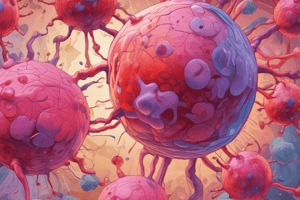Podcast
Questions and Answers
نوتروفیلها پپتیدهای ضدمیکروبی مانند دفنسینها و کاتلیسیدینها را از خود ______ میکنند.
نوتروفیلها پپتیدهای ضدمیکروبی مانند دفنسینها و کاتلیسیدینها را از خود ______ میکنند.
ترشح
نوتروفیلها ROSهای اکسایشی مانند پراکسید هیدروژن، سوپراکسید و رادیکالهای هیدروکسیل تولید ______.
نوتروفیلها ROSهای اکسایشی مانند پراکسید هیدروژن، سوپراکسید و رادیکالهای هیدروکسیل تولید ______.
میکنند
NETs شامل کروماتین (DNA)، پروتئینهای دانهای (شامل پپتیدهای ضدمیکروبی) و دیگر مولکولها ______.
NETs شامل کروماتین (DNA)، پروتئینهای دانهای (شامل پپتیدهای ضدمیکروبی) و دیگر مولکولها ______.
هستند
نوتروفیلها میتوانند مسیرگذاری و تحریک سلولهای دیگر ایمنی به محل عفونت را ______.
نوتروفیلها میتوانند مسیرگذاری و تحریک سلولهای دیگر ایمنی به محل عفونت را ______.
نوتروفیلها میتوانند به التهابات کمک کنند یا برخی بیماریها را تشدید کنند، به عنوان مثال بیماریهای خودایمنی مانند لوپوس اریتماتوس سیستمیک میتواند به افزایش تعداد نوتروفیلها و تشکیل NETs منجر ______.
نوتروفیلها میتوانند به التهابات کمک کنند یا برخی بیماریها را تشدید کنند، به عنوان مثال بیماریهای خودایمنی مانند لوپوس اریتماتوس سیستمیک میتواند به افزایش تعداد نوتروفیلها و تشکیل NETs منجر ______.
Flashcards are hidden until you start studying
Study Notes
White Blood Cells: The Guardians of Your Immune System
White blood cells (WBCs), also known as leukocytes, are a crucial component of your immune system, constantly patrolling your body to detect and eliminate foreign invaders. Among these diverse defenders, neutrophils are one of the most abundant types of WBCs, accounting for about 50-70% of all white blood cells.
Neutrophils: A Closer Look
Neutrophils are granulocytes, meaning they contain granules in their cytoplasm. These granules contain antimicrobial enzymes, such as lysozyme, lactoferrin, and myeloperoxidase, that help combat bacteria and fungi. They have a short lifespan, typically lasting only 1-3 days, and are the first responders to infections.
Neutrophils are attracted to sites of inflammation and infection through a process called chemotaxis, which involves the release of chemical messengers called chemokines. They travel through blood vessels, migrate to the infected tissue, and help prevent the spread of infection.
Neutrophil Function
Neutrophils have several mechanisms to eliminate pathogens:
-
Phagocytosis: Neutrophils engulf (phagocytose) bacteria and fungi, engulfing the pathogens inside vesicles called phagosomes. The pathogens are then killed through a process called phagolysosome fusion, which releases the antimicrobial enzymes and other toxic molecules contained within the granules.
-
Antimicrobial peptides: Neutrophils secrete antimicrobial peptides, such as defensins and cathelicidins, that can directly kill microbes and disrupt their cell membranes.
-
Reactive oxygen species (ROS): Neutrophils produce ROS, such as hydrogen peroxide, superoxide, and hydroxyl radicals, which can damage pathogenic microorganisms and weaken their cell membranes.
-
Neutrophil extracellular traps (NETs): In some cases, neutrophils release NETs, which consist of chromatin (DNA), granule proteins (including antimicrobial peptides), and other molecules. NETs can trap and immobilize pathogens, preventing their spread and facilitating the recruitment of other immune cells to the site of infection.
Neutrophil Dysfunction
Neutrophils are essential for a healthy immune response. However, they can also contribute to inflammation or exacerbate certain diseases. For instance, autoimmune diseases, such as systemic lupus erythematosus, can lead to an increased number of neutrophils and the formation of NETs, which may contribute to tissue damage.
Furthermore, neutrophils can release cytokines and chemokines, which can amplify inflammation. In some cases, this overactivation may lead to complications, such as sepsis, a life-threatening condition caused by a severe immune response to infection.
In summary, neutrophils are the most abundant type of white blood cell, playing a crucial role in your immune system by combating infections through phagocytosis, antimicrobial peptides, ROS, and NETs. However, they can also contribute to inflammation and exacerbate certain diseases when dysfunctional. Understanding the role and function of neutrophils is essential for advancing our knowledge of the immune system and developing new treatments for diseases and infections.
Studying That Suits You
Use AI to generate personalized quizzes and flashcards to suit your learning preferences.




